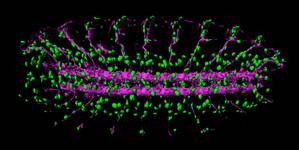Research
Brain is a computational machine that gathers information from sensory organs, integrates them, and provides proper output for motor control. To understand how it works, it is important to obtain a comprehensive knowledge about its organization from input to output. Towards this goal we analyse the whole of a relatively simple brain system rather than focusing on a particular small part of a complex brain. We primarily use the fruit fly Drosophila melanogaster to make the best use of its advanced molecular genetic tools for visualising and manipulating specific cells. With only about 100,000 cells in the entire brain and less than 20,000 neurons per side in its central part, it will not be impossible to understand its entire neuronal network.
Analysing terra incognita of the brain
If you are a tourist, visiting popular locations such as the Cathedral in Cologne and the Brandenburg Gate in Berlin might be enough to get a certain impression about Germany. But if you are a sociologist who want to make detailed analysis of the country, you will have to investigate not only those tourist spots but also lesser-known cities and towns that lie in between. Many neuroscientists focus on popular spots of the brain such as the cerebral cortex and hippocampus in mammals, or mushroom body and central complex in insects. Although such research is important in its own right, we cannot understand the way information is processed in the brain if we ignore the rest of the neurons and brain regions that lie in between.
The brain regions that have historically escaped from extensive research, which we call “terra incognita” of the brain, account for as much as 70% of the brain volume and neuron numbers. They feature extensive connections with each other as well as with known sensory, integration and motor centres. Having analysed the architecture of the visual, olfactory, gustatory, auditory and somatosensory centres as well as learning/memory systems, we now endeavour to identify neurons and analyse their functions of the terra incognita regions in order to establish a comprehensive view about brain organization and function.
Glial cells, often neglected but vital component of the brain
When we watch movies, we tend to notice only actors. But there are many other important players who do not appear on the cinema screen, such as directors, agents, engineers and logistic people. Likewise, although neurones might appear as primary performers of the brain, glial cells are vital for achieving its proper function. We have previously established a systematic classification system of the insect glial cells, which is used widely in the research community, and analysed the roles of various glial cell types in the development, maintenance and reorganization of the nervous system. We continue this effort to reveal the roles of glial cells from embryo to adult.
Movie of the Drosophila glial cells (Data by Tina Altenhein)
Dr. Kei Ito is also the AXA Chairholder [ Profile ] [ Introduction movie ] and had been Senior Fellow of The Howard Hughes Medical Institute (HHMI) Janelia Research Campus

